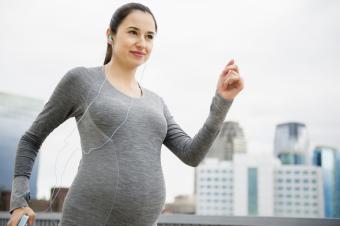
Walking and labor induction go hand-in-hand for many pregnancies. Walking is one of the commonly recommended methods of self-inducing labor naturally and has many advantages. However, walking to induce labor may not be right for every woman.
How Walking Helps to Induce Labor
Many women who have had healthy pregnancies are encouraged to walk when they are very close to or have passed their due date. Does walking help induce labor? Although doctors debate over whether walking actually causes labor to begin, there is a strong correlation between activity such as walking and going into labor. You don't want to engage in strenuous exercise near the end of your pregnancy, but walking to induce labor has a number of benefits for the mother.
- Many women enter into the stages of early labor without fully realizing it and walking can naturally help the labor progress more effectively.
- Walking helps mom be more comfortable, and this can also help the body relax and prepare for labor.
- The anxiety level of many women is also very high near the end of the pregnancy, particularly with first-time mothers, and walking can help alleviate anxiety.
- Walking can help pass the time in the last weeks or days before delivery. The force of gravity and pelvic pressure can help the baby settle into the proper position, another bonus for preparing to give birth.
- The physical movement may also help stimulate the muscles and prepare for contractions.
- The body perspiring during walking may also signal the pituitary gland to increase hormone production, which may in turn have an effect on the hormone oxytocin, which causes labor to begin.
Since there is little hard and fast proof of the relationship between walking and labor induction, many practitioners recommend you employ whatever activities and physical positions make you the most comfortable at the end of your pregnancy.
Walking and Labor Induction Tips
The link between walking and labor induction may not be proven in black and white, but generations of women have sworn by this method. If you feel comfortable moving around and want to walk in late pregnancy, follow these tips.

- Avoid uneven terrain and large numbers of steps; your energy level and balance both decrease dramatically in late pregnancy.
- Walk in safe and familiar areas that are well lit.
- Walk with your partner, friend, or relative whenever possible.
- Walk in comfortable shoes with non-slip soles.
- Drink plenty of water before, during, and after walking to prevent dehydration.
- Avoid walking in extreme temperatures.
- Take breaks as necessary and don't overexert yourself.
- Wear comfortable, breathable, clothes and a supportive maternity bra.
How Much Walking to Induce Labor
If you are walking with the intention to induce labor, you should know that there is actually no definitive distance or length of time that you should walk in order to help get labor started. There is also no evidence that shows walking can induce or speed up labor. A study was performed to determine if walking during active labor would alter the duration of labor or have any effect on other maternal or fetal outcomes. This study had demonstrated that walking had no effect, and that it neither enhanced nor impaired active labor.
Labor Will Happen When Your Body Is Ready
Walking will only induce labor if your body is ready. It may also intensify and regulate contractions if you're already having them. When you walk, gravity pulls the baby downward and puts pressure on your cervix. This will encourage the cervix to dilate. In turn, this will help the baby move deeper into the pelvis and towards the birth canal. It is also possible that the rhythmic movement from walking and the pressure from the baby's head on the cervix could stimulate the release of oxytocin, which is the hormone that triggers contractions. Walking may encourage cervical dilation, but unfortunately it does not guarantee you'll go into labor anytime soon.
When Not to Walk
Walking in late pregnancy is not for everyone. There are a variety of situations when this is not ideal which include the following.
High-Risk Pregnancy
If you have a high-risk pregnancy, it may be important that you go into labor at the hospital in a monitored environment. If this is the case, discuss with your doctor when exactly you need to go to the hospital. You may be able to walk into the hospital while still being monitored.
To Attempt Labor Induction Earlier Than Full Term
Women who are not full term should never attempt labor induction techniques as the baby may need more time to fully develop. Those who are at a risk for premature labor or other complications may also need to avoid walking to keep labor from happening too early. If your 'water' (sac of amniotic fluid) has broken, your practitioner may ask you what color the fluid is; if it's not clear, that could be a sign of meconium (waste) that may pose a danger to the baby. In this case, you may not be permitted to walk even if you are not yet in labor or having contractions since the baby will need to be monitored.
Walking Is Beneficial
Walking can be a healthy and beneficial option for many women in late pregnancy. Although long-believed to be a method for bringing on labor, it is not guaranteed, and you should do only those activities you feel comfortable doing.







